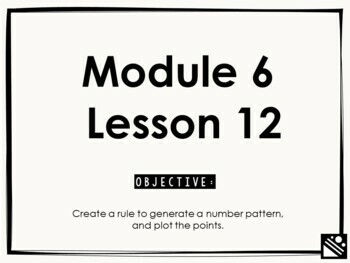Math Presentation for Google Slides™ - 5th Grade Module 6 Lesson 12
Engaging Teacher
641 Followers
Engaging Teacher
641 Followers

Made for Google Drive™
This resource can be used by students on Google Drive or Google Classroom. To access this resource, you’ll need to allow TPT to add it to your Google Drive. See our FAQ and Privacy Policy for more information.
Description
Teach Engage NY Math easily using Google Slides™!
These presentations include slides for each component of the lesson including: Fluency, Application Problem, Concept Development and Student Debrief.
Teaching Engage NY Math using these presentations will:
- Reduce prep time and improves lesson pacing as you don’t have to refer back to the teacher’s manual during the lesson.
- Let anyone follow along. Now, you can feel comfortable leaving the Engage NY Math lesson for substitutes to teach.
- Keep the lesson on track - both you and the students have a visual reminder of what is coming up next in the lesson.
- Help you recover when the lesson goes “off course”.
Adorable “Dot Dudes” theme keeps students engaged throughout the lesson.
Unabridged lessons allow you to teach the curriculum with fidelity.
Editable text gives you the opportunity to customize lessons for your classroom. To secure the clip art I use in my products, the slide backgrounds are not editable.
This product aligns with Engage NY Math, a free program. I am selling my time and creativity in designing supplemental (and engaging) presentations specifically for Google Slides™.
Total Pages
Answer Key
N/A
Teaching Duration
N/A
Last updated Jan 21st, 2021
Report this resource to TPT
Reported resources will be reviewed by our team. Report this resource to let us know if this resource violates TPT’s content guidelines.
Standards
to see state-specific standards (only available in the US).
CCSS5.OA.A.2
Write simple expressions that record calculations with numbers, and interpret numerical expressions without evaluating them. For example, express the calculation “add 8 and 7, then multiply by 2” as 2 × (8 + 7). Recognize that 3 × (18932 + 921) is three times as large as 18932 + 921, without having to calculate the indicated sum or product.
CCSS5.OA.B.3
Generate two numerical patterns using two given rules. Identify apparent relationships between corresponding terms. Form ordered pairs consisting of corresponding terms from the two patterns, and graph the ordered pairs on a coordinate plane. For example, given the rule “Add 3” and the starting number 0, and given the rule “Add 6” and the starting number 0, generate terms in the resulting sequences, and observe that the terms in one sequence are twice the corresponding terms in the other sequence. Explain informally why this is so.
CCSS5.G.A.1
Use a pair of perpendicular number lines, called axes, to define a coordinate system, with the intersection of the lines (the origin) arranged to coincide with the 0 on each line and a given point in the plane located by using an ordered pair of numbers, called its coordinates. Understand that the first number indicates how far to travel from the origin in the direction of one axis, and the second number indicates how far to travel in the direction of the second axis, with the convention that the names of the two axes and the coordinates correspond (e.g., 𝘹-axis and 𝘹-coordinate, 𝘺-axis and 𝘺-coordinate).
CCSSMP3
Construct viable arguments and critique the reasoning of others. Mathematically proficient students understand and use stated assumptions, definitions, and previously established results in constructing arguments. They make conjectures and build a logical progression of statements to explore the truth of their conjectures. They are able to analyze situations by breaking them into cases, and can recognize and use counterexamples. They justify their conclusions, communicate them to others, and respond to the arguments of others. They reason inductively about data, making plausible arguments that take into account the context from which the data arose. Mathematically proficient students are also able to compare the effectiveness of two plausible arguments, distinguish correct logic or reasoning from that which is flawed, and-if there is a flaw in an argument-explain what it is. Elementary students can construct arguments using concrete referents such as objects, drawings, diagrams, and actions. Such arguments can make sense and be correct, even though they are not generalized or made formal until later grades. Later, students learn to determine domains to which an argument applies. Students at all grades can listen or read the arguments of others, decide whether they make sense, and ask useful questions to clarify or improve the arguments.





